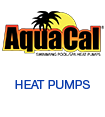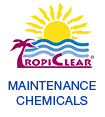My unit does not seem to be producing chlorine...
1) What is your chlorine level?
- a) If zero, go to next question
- b) If above zero, did you add chlorine manually?
- If yes, wait a week then retest without manually adding chlorine.
- If no, your system is working properly.
2) Is your salt between 3,000-3,500 ppm?
- a) If yes, did you have this independently tested by a pool store?
- b) If no, go to pool store and add salt accordingly. If variance with system, then calibrate unit.
- How do I calibrate my AutoPilot for salt?
3) Is stabilizer between 60-80 ppm (Total Control 30-50 ppm)?
PLEASE NOTE THAT THERE IS NO NEED FOR STABILIZER IN INDOOR POOLS
What is stabilizer/Cyanuric Acid?
4) What is the pump run time?
5) What output percentage are you operating at?
- a) If lower than 70%, increase percentage.
- b) If higher than 70%, increase power level.
6) What power level are you operating at?
If all answers are ideal and you are still having problems, call Customer Support to schedule a service call.
What do I need before calling Customer Support?(close)
Before calling Customer Support, please be prepared with:
- model and serial number of your unit
- your salt level test results within the last 30 days
- your pH
- your cyanuric acid/stabilizer lever (sunscreen)
- your hours of operation per day
Location of Serial Numbers
Serial numbers on Cells and Units are located as indicated below, either a Stamped/Written Serial number or a Barcode.

How many hours do I need to run my AutoPilot? (close)
What should the proper chlorine levels be?
Your Chlorinator is designed to run when your water pump is in operation. It will not produce chlorine if the water is not moving through the system.
You need to ensure that the water pump runs long enough to maintain the correct sanitizer levels as shown below. (A minimum of a eight-hour water pump run time is usually required.)
According to the National Swimming Pool Foundation, on a residential pool application the free available chlorine levels should not fall below 1 part per million. (Certified Pool - Spa Operator Handbook, 2006, 2-3)
Ideal chlorine levels range from 2 to 4 parts per million in pools, and from 3 to 5 ppm in spas.
Therefore, you will need to monitor your chlorine levels in your pool and adjust the water pump runtimes accordingly.
What do I do if I don't want to run the pool pump that long?
If the pump is running shorter run times per day, you may need to do the following things to compensate for the higher chlorine needs.
- Increase the purifier output percentage on the chlorinator
- Increase the cell power (These higher levels can decrease the life of your cell)
Do I need to run the chlorinator longer when the water is hot?
Yes. In the summer months, chlorine will be used up quicker. As a result, you will need to increase the time the chlorinator operates or adjust your chlorine output or power levels to compensate.
How much salt should I add? (close)
Enough for 3000 ppm (parts per million) as a starting point. So depending on the initial salt level of your water, you only add the amount needed to establish 3000 ppm. For new pools or freshly filled pools, the salt level will most likely be zero. In this case, 50lbs of salt per 2,000 gallons of water will establish 3000 ppm. For existing pools, the previous usage of chlorine bleach or tablets will have already introduced a level of salt into the water. Have the water tested first then add the appropriate amount to establish 3000 ppm.
Calculate how much salt is needed
For new pools or freshly filled pools, the salt level may be zero. In this case, 50lbs (23 kg) of salt per 2,000 gallons (7570 liters) of water will establish 3000 ppm (mg/L). Note: Salt content in fill water will very from location to location. Always test the water after initial fill of the pool to determine the salt content and then add the appropriate amount of salt as calculated.
For existing pools, the previous usage of chlorine bleach or tablets will have already introduced a level of salt into the water. Have the water tested first then add the appropriate amount to establish 3000 ppm (mg/L) minimum.
What do I do if I added too much salt?
To reduce the salt level, dilution is the solution. Drain some water and refill with fresh water.
Oversalting will not harm your Pool Pilot system, but will lead to a salty tasting water. For some, this is not undesirable, as it will more closely match our body's natural salinity level, making it more comfortable to swim in. If it is too excessive (over 6000 ppm (mg/L)), you can sustain corrosion damage to metallic equipment such as stainless steel handrails, ladders and filters, light rings, or copper heat exchangers.
How often do I need to add salt?
After the initial dosage of salt, you will only need to add salt when necessary. The most common ways salt is lost is through leaks, rainwater overflow, filter backwashing, and bather splashout/carryout. Normal water evaporation does not lose salt, it increases the concentration. The make up water added to bring the water level back to normal will then reduce the salt concentration back to 3000 ppm (mg/L). The Digital and Soft Touch units both have low salt indicators, with the Digital going further to provide the proper salt amount needed to reestablish 3000 ppm (mg/L) minimum (based upon the programmed pool volume input).
What kind of salt do I use?
It is important to use Sodium Chloride (NaCl) salt that is greater than 99% pure. Common types of salt include granular food grade, water softener pellets or solar salt flakes. These are usually available in 25 lb (11 kg) to 80 lb (36 kg) bags at a local pool or building supply store. Water softener and solar salt will have a slower dissolve rate than food grade salt. Rock salt and granular salt with Iodine or rust preventatives should NOT be used as they contain high levels of impurities that will cause staining.
Note: Granular Salt, Table Salt or Water Conditioner Pellets can also be used but will have different dissolve rates. If the salt you use contains Iodine or YPS (an anti-caking additive), constant brushing will help the dissolve rate and prevent staining due to the additives in the salt. Ensure that the salt you use contains a minimum purity of 99% Sodium Chloride (NaCl).
We recommend the use of AutoSoft PlusTM Water Conditioning Salt. AutoSoft PlusTM salt contains 99.8% pure Sodium Chloride (NaCl) without Iodine or the Anti-Caking additive, Yellow Prussiate of Soda (YPS). Iodine and YPS can cause a localized tint to the water or yellow staining on the pool surface finish if allowed to rest un-dissolved on the finish for extended period of time. AutoSoft PlusTM is blended with the proper amount of stabilizer to maintain a proper level within the recommended range when added according to the salt chart in the owner's manual.
(NOTE: Do not use Rock Salt due to its high levels of impurities.)
Where do I put the salt?
What is most important when adding salt is to brush it around until it is dissolved. This is accelerated by turning your pump on, opening the bottom drain and adding the salt over the drain, rather than walking around the perimeter while adding the salt.
It is recommended that you continue to run the pump for 24 hrs so the salt can spread evenly throughout the pool.
If there is no main drain, a vacuum head can be used to circulate the salt. Vacuum the salt, brush it around to agitate, or brush into the main drain (if applicable) to speed up the dissolving process. With Granular salt, 60-70% will have dissolved before hitting bottom. The remaining salt can simply be brushed into the drain, which will then complete dissolution. With all other forms of salt, it will take longer to dissolve but the same process will accelerate the dissolve rate. Simply brush the salt in a pyramid over the drain to increase dissolution.
(Caution: Do not use a pool cleaner or vacuum head with wheels as they can leave track marks on newly plastered pools. Do not allow Granular salt to pile up in one location without brushing as staining may occur.)
What is stabilizer/Cyanuric Acid? (close)
Cyanuric Acid, or CYA, is a chemical compound that protects chlorine from being destroyed by the sun. The sun’s ultraviolet (UV) rays will make the chlorine in an outdoor pool dissipate quickly. In fact, an ideal level of chlorine in an “unstabilized” pool or spa can be lost in less than two hours on a bright sunny day, due to the UV rays of the sun. Cyanuric acid acts as a “stabilizer” that helps chlorine hold up better when exposed to the UV rays. You can think of cyanuric acid as blocking the effect that the sunlight has on breaking down the chlorine-kind of like a sunscreen for your pool.
How much Stabilizer should I add? (close)
How much stabilizer is needed?
It is important for outdoor pools to maintain a stabilizer or Cyanuric acid level (CYA) of 60 - 80 ppm for all systems except the Total Control, which should be maintained at 30-50 ppm.
This protects the chlorine from the degradation effects of the sun's UV rays. This is similar to using sunscreen for your chlorine.
With low or no Cyanuric acid it is possible for the chlorine being produced, to be used up just as quickly as it is generated
Some things to note:
-
The terms "stabilizer", "CYA", and "Cyanuric Acid" all refer to the same substance.
-
Without Cyanuric acid, the cell is forced to run for longer periods of time (with a higher Purifier Output percentage need) in order to maintain chlorine levels, which will deplete the cell faster than normal.
-
A reduced level of 30-50 ppm is needed for the Total Control system
-
Cyanuric acid is not needed for indoor pools or outdoor pools/spas that are constantly covered. However, it is recommended to add about 15 ppm to avoid corrosion on metals.
-
When adding stabilizer it is recommended to premix the stabilizer with water then add into the pool. It is critical to use this method with the Total Control system, as the "acid" from the stabilizer will have a negative affect on the ORP and PH probes. If adding Stabilizer to the skimmer with a standard (not a Total Control) system, do not clean or backwash the filter for several days afterwards as undissolved cyanuric acid will "sit" in the filter until dissolved.
Calculate how much stabilizer is needed
How do I Calibrate my Chlorinator for salt? (close)
You MUST use a reliable test kit to verify the salt level. Be sure that the pump has been running for several minutes before calibrating the salt display. If the test result is different from the display, recalibrate (in 100 ppm increments) until the unit matches your test result.
This is applicable only to the following units:
POOL PILOT PROFESSIONAL
-
Press the "SERVICE" button
-
Press the Arrow UP OR DOWN to "CALIBRATE SALT"
-
Press the "SERVICE" button
-
Adjust the salt display to match the reading of your test by pressing the UP or DOWN arrows
-
Press the "SERVICE" button to lock in the adjusted calibration and to return to the main display
(There is a delay after you press the SERVICE button to exit. Do not press again.)
POOL PILOT DIGITAL
-
Press MENU button
-
Press Arrow UP to MAINTENANCE MENU, then press SELECT
-
Press Arrow UP to CALIBRATE SALT, then press SELECT
-
Adjust the salt display to match the reading of your test by pressing the Arrow UP or DOWN
-
Press SELECT (the unit will take some time to recalibrate the salt display)
-
After calibration is done, "EXIT MENU", press SELECT to return to main display
POOL PILOT SOFT TOUCH
FIRST, locate the "Concealed Set Up Button" found on the control panel. This will be used to change the salt settings on the unit.
This button can be found by feeling the label to the right of the "SALT OK" light. Remember where this button is located. You will press it later in the instructions.

-
Press and hold both the UP and DOWN buttons simultaneously for approximately 5 seconds. Release the buttons when the "PURIFIER OUTPUT" lights all go out. The first light starting from the bottom up will light up and remain lit during the salt calibration process. This light indicates "SALT MODE".
-
The measured salt will be shown by the flashes of the 5th and 6th lights. For example, the 6th light flashes 2 times and the 5th light flashes 5 times, the salt measurement is 2,500 ppm of salt.
-
While the Self Diagnostic is displaying the "Salt Display", press and release the Hidden button. The Salt Display will flash again, after which the SALT LIGHT will blink.
-
Press the UP or DOWN Arrow, according to the necessary adjustment. The new salt reading will display after each press UP or DOWN (100 ppm increment). I.e., to increase from 2500 ppm to 3000 ppm, you must press the UP arrow and wait for the salt display 5 times (be patient).
-
After adjusting to the new salt calibration reading, 1 of the 3 lights located under SALT on the faceplate will blink 10 times before resuming to normal operations.
(PLEASE NOTE: WAIT 3 MINUTES BEFORE DOING A DIAGNOSTIC CHECK TO SEE NEW READINGS.)
How do I Clean my Cell? (close)
WARNING -- Always use safety precautions when handling acid by wearing rubber gloves and safety goggles.
Clean your cell if the cell blades have any calcium build up as shown below.
 Please note: You cannot always see Calcium unless the blades are dry.
Please note: You cannot always see Calcium unless the blades are dry.
The Cap method
-
Turn off your water pump
-
Loosen the unions as indicated on the cell manifold

-
Remove the cell and place a cap or plug on the end of the cell as shown
 Plugs are available at any pool supply warehouse or home improvement store. Ask for a 1.5" MPT clean out plug
Plugs are available at any pool supply warehouse or home improvement store. Ask for a 1.5" MPT clean out plug
-
Fill the capped cell with water 2 inches from the top of the cell blades.
-
Fill the rest of the cell with Muriatic Acid. This allows for an approximate 1 to 4 solution.
Always add the acid to the water. If you do it the other way around it can cause the solution to spray back at you and cause serious injury.
-
Allow the solution to sit in the cell for up to 20 minutes.
-
Safely dispose of the solution. (Putting it back into the pool is recommended)
-
Remove the cap and rinse the cell with light water pressure, inspect, and repeat acid washing if the cell is still scaled.
Once the cell has been cleaned, dry off the cell electrical terminals, reassemble the manifold, and return the system to service. Warning: The electrical terminals must be completely dry to avoid corrosion and failure of the cell or cable.
Troubleshooting Guides
















